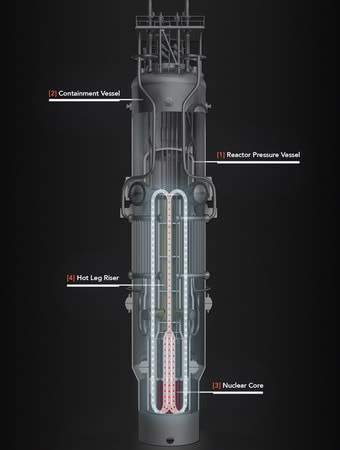
An energy startup has created a modular reactor that is dramatically smaller than a conventional one—and could be much safer as well.
The NuScale Power Module (NPM) technology is closely based on conventional reactor technology, but is significantly more modern and efficient. It is a light water reactor that incorporates steam generation and heat exchange components into one efficient integrated unit. Each NPM can operate independently within a module or cluster; up to 12 NPMs can be operated and monitored from a single control room.
The NPM is a mere 65 feet tall and nine feet in diameter, and sits inside a containment structure 76 feet tall and 15 feet in diameter. About 100 NPMs would fit inside the containment chamber of a large conventional reactor.
The core of the NuScale reactor is kept cool via running water—the same way that existing reactors stay cool. But while most of a conventional reactor’s facility is taken up by cooling pumps, the NPM uses gravity and buoyancy to naturally circulate the water. The NPM is encased inside a water-filled pool built below grade. As water passes over the core it becomes heated and rises. When the heated water reaches the top of the reactor’s interior, it is then drawn down by cooler water passed through the steam generator. As cooler water has a higher density than hot water, that water sinks to the bottom of the reactor where it flows over the core again, completing the cycle. The water in the reactor system and the water in the steam generator are kept separate to avoid contamination.

Each NPM’s power output is 60 megawatt electrical (MWe) or 200 thermal MWe, which is proportionately small to the massive existing reactors, the largest of which can generate 8,000 MWe.
The NPM can be built in a factory and shipped anywhere, even to remote locations, for final assembly and installation. It can also be installed closer to the area it’s meant to power, reducing infrastructure and transmission costs. The company has run simulations that indicate it could handle almost any emergency without triggering a meltdown.
NuPower’s prototype is being reviewed by the Nuclear Power Commission, which could approve the NPM for commercial use as early as September 2020. The company has already signed a contract to build a 12-unit plant at the Idaho National Laboratory and could start generating power by 2026.
Many of the U.S.’s aging nuclear reactors will need to be overhauled or decommissioned in the near future—but they provide two thirds of the country’s renewable energy. Small reactors like the NPM could be a new and innovative source of carbon-free power.
Read more about innovations in nuclear power at Russia Put a Nuclear Power Plant on a Boat.